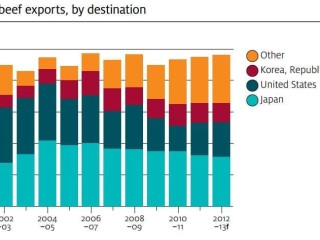 Shifting international demand for Australian beef from higher value chilled beef markets towards lower value frozen beef markets will underpin a slight easing in saleyard cattle prices over the next 12 months, according to the Australian Bureau of Agriculture, Resource Economics and Sciences.
Shifting international demand for Australian beef from higher value chilled beef markets towards lower value frozen beef markets will underpin a slight easing in saleyard cattle prices over the next 12 months, according to the Australian Bureau of Agriculture, Resource Economics and Sciences.
In its latest commodity forecast, ABARES says changing dynamics in export demand, and an expected wane in restocker buying power after two successful years of herd rebuilding will place some downward pressure on saleyards prices in the year ahead.
The Australian weighted average saleyard price of cattle was 330c/kg in 2011-12, and is forecast to ease by 3pc to 320c/kg in 2012-13.
The forecast has been revised slightly down from the 325c/kg average ABARES predicted for 2012-13 during its annual outlook conference in Canberra in March.
"Demand for restocker cattle is exepected to fall during 2012-13 in response to successful herd rebuilding over the past two years, which has resulted in the national herd increasing to its largest (size) since 1976–77.," the report said.
"In addition, shifting international demand for Australian beef, from higher valued chilled and grain fed beef toward lower value frozen and grass fed varieties, is likely to adversely affect export prices, which will in turn place downward pressure on domestic saleyard prices."
ABARES believes the national herd will stand at 30.2 million head on June 30, 5pc higher than last year. It expects the herd to grow by a further 4pc to 31.4m head in the next 12 months.
Slaughter rates over the past year have been at their lowest levels since 1988-99, totalling 7.9m head for 2011-12. The forecast for the next financial year is for slaughter rates to increase by 2pc to 8.1m head, for beef production to increase 2pc to 2.2 million tonnes.
ABARES says cattle markets can expect to see increasing yardings of older cattle in the year ahead in response to growing import demand from grinding meat customers such as the US and other smaller markets. Driving greater sales to the US will be ongoing falls in US beef production, the gap in supply created by the removal of Lean Finely Textured Beef from sale and increasing volumes of US beef exports to North Asian, Canadian and Russian markets.
Export outlook
 Australian beef exports are set to rise by 2pc to 970,000 tonnes next year, as shipments to the US and smaller markets such as Chinese Taipei, the Middle East and South East Asian nations (with the exception of quota-limited Indonesia) rise.
Australian beef exports are set to rise by 2pc to 970,000 tonnes next year, as shipments to the US and smaller markets such as Chinese Taipei, the Middle East and South East Asian nations (with the exception of quota-limited Indonesia) rise.
Chinese Taipei (Taiwan) has increased imports of Australian product by 23pc to 38,000t in the past 12 months, filling a gap in supply left by US product. The country’s food regulators increased the number of tests on beef imports for the banned substance ractopamine, which has resulted in a near cessation of beef shipments from the US, where ractopamine is widely used.
Growth to smaller markets has helped to offset lower exports to the Russian Federation and Indonesia.
However exports to traditional high value markets of Japan and Korea are expected to decline as US competition and higher domestic production of beef results in reduced demand for Australian product.
Live Exports
Total Australian live cattle exports of live cattle in 2012-13 are forecast to fall by 6pc to 500,000, reflecting reduced shipments to Indonesia and limited capacity of other export markets to accept surplus cattle.
Latest live export data also reflects the decline in exports to Turkey this year. Australia’s second largest market in 2010-11, shipments to the destination have more than halved in the past 12 months due to increased import competition in the market from Hungary, France and Uruguay.
Rural export earnings to remain high
ABARES says the overall picture for agriculture is strong, with rural export earnings forecast to remain high at around $34.4 billion in 2012-13.
Minister for Agriculture, Fisheries and Forestry, Senator Joe Ludwig, says the outlook is positive, with agricultural export earnings above the long term average.
Minister Ludwig said this figure was slightly lower than earlier forecasts, affected by lower prices for some commodities.
“While there has been a slight decline in commodity prices, continued demand in the Asian region and consistent quality products continue to ensure Australia’s export competitiveness on the world stage,” Minister Ludwig said.
“Flooding in Australia in 2011-12 impacted some farmers and reduced production in the affected areas.
However, the widespread rainfall in other districts has supported strong forecast figures.”
